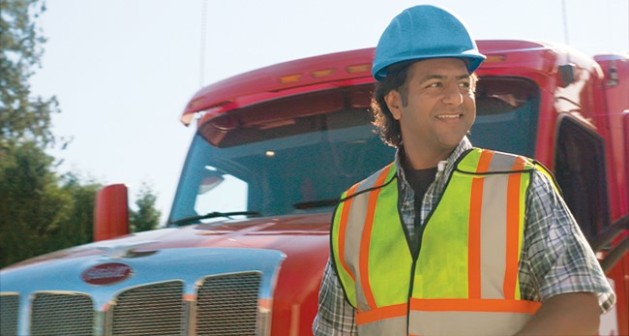Keep Yourself Safe on the Job
Did you know?
Most serious injuries to professional truck drivers occur when you’re not behind the wheel
As a commercial driver, when you think about your job, it’s unlikely that you imagine getting injured by falling from a height. However, falls are the third-leading cause of injury for truck drivers, following overexertion injuries and motor vehicle incidents.
Preventing falls from a height
Falls from a height is a common cause of injury that shouldn’t be overlooked.
One in three falls happen when the driver exits or enters the cab, 18 percent occur during vehicle inspections, maintenance, and repairs, and 14 percent of falls happen while drivers are unloading cargo. Fortunately, work-related falls are preventable.
Easy “steps” to staying safe
Staying safe on your feet starts with wearing suitable footwear, being aware of your environment and the work surfaces you’re about to walk on and keeping your hands free.
- Does your footwear have slip-resistant soles and provide good support?
- Are there tripping hazards, obstacles or mobile equipment in your work area?
- Are steps and other surfaces — such as the fifth-wheel deck, trailer deck, and ground below — slippery or wet, or covered in snow, ice or grease?
- Always avoid climbing down from the cab or trailer with clipboards, boxes, or other items in your hand.
Use three points of contact every time
One of the easiest ways to avoid injury as a commercial truck driver is to use three points of contact every time you climb up or down from a height. By always facing the vehicle and keeping two hands and one foot — or two feet and one hand — on the vehicle or equipment at all times you can eliminate or minimize the chance of an injury.
Preventing overexertion injuries
Working in commercial trucking also involves other actions or movements that can cause overexertion injuries. Actions and movements that can result in sprains and strains include:
- Working in awkward postures and repeating the same movements frequently, such as bending forward, twisting, or reaching over shoulder height or to the side.
- Holding the same position for an extended period.
- Getting in and out of the cab.
- Applying force – for example when using pry bars to cinch the straps, especially after sitting for a long time.
Landing gear safety
- In order to reduce the strain on your body, have the truck do the work for you.
- Whenever possible, use a puller pin to assist in releasing the fifth wheel, use the air ride suspension to release tension from the landing gear and pin, and eliminate manual cranking by using an adapted gear drill to crank the gear for you.
- Use the right gear; low gear when the force to crank the landing gear is high, and high gear when the force to crank the landing gear is low.
- Maintain your landing gear – raise the landing gear fully and put the handle in the stowed position before each trip to limit damage and wear and tear.
Pry bar safety
- Select a tool that was designed for the job and check that it’s in good working condition before using it.
- Work from a balanced position and make sure your body is not directly over the pry bar.
- Be aware of your environment and identify what is happening in and around your work area. Assess if any factors create a risk of injury to you, t
- hose around you, or both.
Strapping safety
- Replace straps that show signs of wear and tear – don’t alter or attempt to repair straps that have been damaged.
- Check that straps are properly secured.
While this advice may seem like “safety 101” for most drivers, it’s important to note that injuries can happen to even the most experienced workers..
Following proper safety techniques and taking a little extra time will help keep you injury free and on the road. With a few simple steps, you can stay safe and avoid serious injury.
For more information
Find health and safety resources, including three new safety videos, for commercial truck drivers at worksafebc.com/transportation.
Have your say
This is a moderated forum. Comments will no longer be published unless they are accompanied by a first and last name and a verifiable email address. (Today's Trucking will not publish or share the email address.) Profane language and content deemed to be libelous, racist, or threatening in nature will not be published under any circumstances.

Quote:
“Most serious injuries to professional truck drivers occur when you’re not behind the wheel”
RIGHT ! The most serious injury happens when you sign on to drive for a BIG carrier et Al ! Most don’t pay a fair wage nor for all HOS . They exploit you on HOS ! Don’t pay you for overtime over 40 hours . They break the law by forcing you to accept a forward facing camera recording you while behind the wheel . They jib you on the amount of miles you drive through PC miler BS ! ETC ETC ETC !
They talk about safety and don’t have trucks designed for safety ! Where’s the roll cage ??? Where’s driver protection against fuel hauling in case of it igniting in a collision ???
The whole truck design concept is from the dinosaur era ! Tires blowing out , god forbid it happens while a motorcyclist is riding next to the tire blowout on a highway ………..
In my humble opinion !